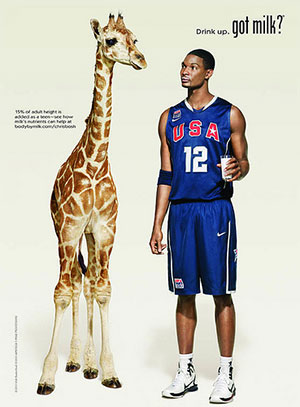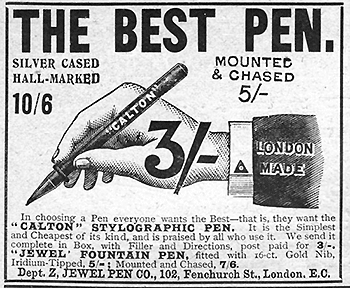
Source: Pushy advertising, Joe McCarthy, Flickr
Advertising is the art of convincing people to spend money they don't have for something they don’t need.
This quote by humorist Will Rogers is pretty cynical, but it’s also pretty accurate. That’s not to say that advertising isn’t helpful, though. You can probably think of at least one instance in which you saw an ad for a product that you didn’t know about, but you said to yourself, “I want that!” For example, you might have seen an advertisement for a new type of exercise equipment and decided to make a purchase. Companies need you to get out there and shop, and they need you to choose their product over another. That’s where advertising comes in.
The goal of advertising is to sell you something. Advertisers use various techniques to persuade consumers to choose their product over another. The U.S. government has specifically made lying about a product in order to sell it illegal, but other methods of manipulation and persuasion are allowed. You must always remember when you are consuming advertising that the people who create the ads use heavily researched techniques to get you to think what they want you to think about their products.
Audience and Purpose Determine the Message

Source: media literacy, Pip Cleaves, Flickr
Using the term media literacy may make evaluating and interpreting media seem mysterious and complicated, but you will be employing knowledge that you use all the time when you are reading and writing for school. Just as you have learned to analyze the audience and purpose of what you read and write for class, understanding the audience and the purpose for an advertisement can help you figure out its explicit and implicit meanings. Ask yourself:
- Who is the audience for the message?
- How old are they? The age of the consumer is a very important factor in deciding how to approach them.
- What do they like or dislike?
- How do these likes or dislikes impact their view of or need for the product?
- What is the purpose of the message?
- What is the product being sold?
- What problem is the product going to solve?
Take a look at the two ads below from the California Milk Processor Board’s “Got Milk?” campaign. This is one of the most famous and recognizable advertising campaigns. Now, review the analysis chart that follows the ads.

Source: Chris Bosh got milk?, Body by Milk, Flickr

Source: SPL291367_001, Sr. Q, Flickr
| Ad 1 | Ad 2 | |
|---|---|---|
| Audience | Teen boys are the target audience. | Older men and maybe women, too, are the target audience. |
| Purpose | The ad is trying to get more teens to drink milk. | The ad is trying to get more older adults to drink milk. |
| Explicit message | Milk’s nutrients can help teens grow. | Drinking milk adds nutrients that are missing from your diet. |
| Implicit message | If you drink milk, you can be healthy like a professional athlete. | If you drink milk, you can still look good when you’re in your sixties. |
The purpose for each ad is essentially the same: to sell more milk. The audience differs, though, so the ads differ. The explicit messages are designed to interest different audiences. Teen boys worry about growing taller. Adult men and women are no longer growing, but they worry about staying healthy as they age. With these ads, the milk producers are telling both audiences that milk is the solution to their problems. The implicit messages for each ad tell the audience that not only can milk give them what they need (nutrients for a healthy body), but it can also give them what they want. Ad 1 assumes that teen boys want to be like professional athletes. The ad implies that if they drink milk, they might become just as strong as a professional athlete. Ad 2 assumes that men and women want to look good as they age. This ad implies that drinking milk will help them stay healthy and look good as they age.

Source: SPL291367_001, Sr. Q, Flickr
Advertisers craft their messages by using persuasive appeals to connect with the consumer. Common types of appeals include the following:
Bandwagon appeal: Advertisements that connect with the consumer by implying that everyone is using this product, and the consumer will be missing out if they don’t “jump on the bandwagon” and use it too
Testimonials: Advertisements that make a claim about a product by reporting the experiences of actual users
Endorsements: Advertisements that use testimonials from celebrities to sell a product
Stereotypes: Advertisements that use widely held assumptions about a person or thing to sell a product. For example, “all girls like pink” is a common stereotype.
The Wheaties ads you looked at in the Section 1 are endorsements. Celebrities lend their images to the product and in doing so tell the consumer to “Eat Wheaties to be successful like me!” The “Got Milk?” ads use endorsements and stereotypes to connect with customers. The Chris Bosh ad plays on the stereotype that teen boys dream of being professional athletes.
Understanding the appeal or appeals being used help us to interpret the implicit message in an ad.
 Now, it’s your turn to determine the audience, purpose, explicit, and implicit messages for an ad. Watch the McDonald’s commercial below. Then, use your notes to record the audience, purpose, explicit message, and implicit message. You can create an analysis chart like the one you reviewed above. When you are finished, check your understanding to see a sample chart.
Now, it’s your turn to determine the audience, purpose, explicit, and implicit messages for an ad. Watch the McDonald’s commercial below. Then, use your notes to record the audience, purpose, explicit message, and implicit message. You can create an analysis chart like the one you reviewed above. When you are finished, check your understanding to see a sample chart.
Source: Minion Madness at McDonald's! Commercial McDonald's Global 2, les mignons, YouTube
Sample Response:
| Audience | Kids and their parents are the target audience. |
| Purpose | The ad is trying to get families to eat at McDonald’s. |
| Explicit message | McDonald’s Happy Meals have milk, apple slices, and a Minion toy. |
| Implicit message | Food at McDonald’s is not only fun but also healthy. |